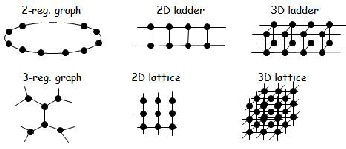Condensation in ZRP: particles (initially distributed at random) form clusters and finally produce a condensate. The hopping rate u(m)=1+3/m where m is the number of particles at the departure site.
I have calculated (with I. M. Sokolov) finite-
I have also developed (with L. Bogacz, Z. Burda and W. Janke) a computer program
based on sampling the space of random graphs, which allows for generating networks
with desired features such as the power-


Random matrices
Random matrices are, loosely speaking, matrices which elements are random numbers. For example, each element may be drawn independently from a Gaussian (normal) distribution. In more complex situations, whole matrices are drawn from a statistical ensemble, and each matrix is treated as an object having a certain probability of occurrence.
Random matrices were introduced to physics by E. Wigner who considered the problem of calculating the energy spectrum of atomic nuclei. He approximated the complicated (and unknown at that time) Hamiltonian of the nucleus by a random matrix and observed that the resulting distribution of spacings between energy levels agreed well with experiments. More recently, random matrix theory has been applied to quantum chaos, signal processing and wireless communication, quantum gravity, and stock markets.
In my work, I studied hermitian and non-
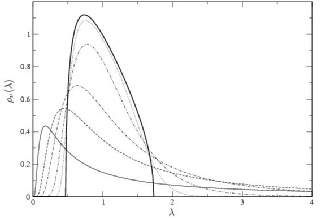
I have calculated (with A. Goerlich and Z. Burda) the spectrum of the covariance matrix for a class of “radial” matrix ensembles. Figure shows the spectrum for the Wishart ensemble (Gaussian random numbers, thick line) and Student ensembles with increasing degrees of freedom. See this paper for more details.
Density of eigenvalues (spectrum) in the complex plane of a product of two random matrices is very simple and highly universal: r(z)=1/(2p|z|). A similar, universal result holds for a product of more than two matrices (paper).
Random graphs and complex networks
Graphs are objects which consist of nodes connected by links. A simple, two dimensional
grid is an example of a regular graph. In random graphs, the way the nodes are connected
is to some extent random. Maximally random graphs (with links distributed completely
at random) were first studied by Erdös, Rényi and their followers as part of mathematical
graph theory, but in recent years Albert, Barabási, Watts, Strogatz, and others have
shown that many real-
These so called “complex networks” (CN) are neither completely regular as for example
a 2d lattice, nor completely random as Erdös and Rényi graphs. Various models have
been proposed to explain common properties of many CN such as power-
In my research, I was interested in developing a general theory of complex networks, based on such concepts of statistical mechanics as statistical ensemble and partition function. Here you can find my publications related to networks and random graphs. Some results are briefly mentioned in the right panel.
Statistical theory of networks: graphs in the canonical ensemble with 5 nodes and 4 links, their weights calculated as Feynman symmetry factors, and their probabilities of occurrence. See here for details.

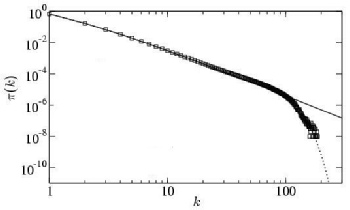
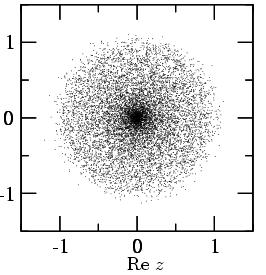
Zero-
Many physical processes are far from equlibrium, which means that macroscopic currents
or flows are present in the system. The zero-
I worked on the phenomenon of condensation in ZRP: for some choices of the hopping
rate and/or the structure of the network, a finite fraction of particles “condenses”
at a single node if the density of particles exceeds a critical value. For regular
lattices, the condensate takes place at a randomly chosen node -
I also considered simultaneous evolution of particles and networks, and extensions
of ZRP to more complicated hopping rates depending on the state of neighbouring nodes
(with J. Sopik, H. Meyer-
Recently, I have discovered (with M. Evans) a new “explosive” condensation in which
the process of condensate’s formation accelerates in time (video on the right). This
is probably the first example of instantaneous gelation (known so far only from mean-
I have also co-
“Explosive” condensation: the rate at which a cluster of particles moves through the system increases with its size, similarly to a rain drop falling through the mist.
The condensate becomes spatially extended particles located on neighbouring sites can interact (see papers).
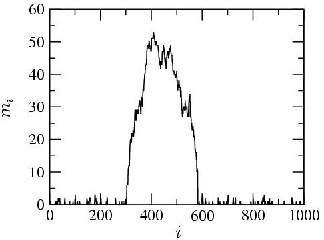
Some other problems
Random walks. I and my colleagues (Z. Burda, J. Duda and J.-
Spin glasses. I developed (with Z. Burda) a new, perturbative method of counting
the number of metastable states in Ising spin glasses. We obtained results for regular
two-
Effective models of causal dynamical triangulations (CDT). CDT is a computer-
Localization of the probability (white areas in the plot) of finding a random walker maximizing the entropy of trajectories in the presence of defects (randomly removed links of a 2d lattice are indicated by pairs of dots).
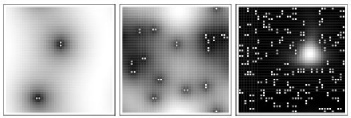
Various regular graphs for which we calculated the number of metastable states in
spin glasses with Gaussian distribution of couplings. The number N of such states
grows exponentially with the number of spins n, N = exp(A*n). A non-
